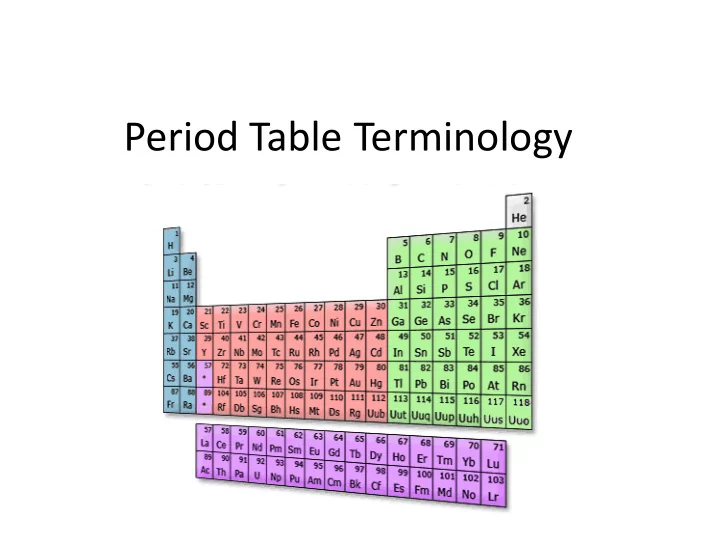

Period Table Terminology
Historical Development As scientists around the world began to discover more and more elements, the list of elements became over whelming. Several different scientists thought that there must be a pattern. The problem of sorting the elements was made more difficult by not having all the main elements discovered and some of the “elements” were actually compounds/molecules.
Historical Development Dmitri Mendeleev is responsible for creating order and highlighting patterns in the periodic table. He organized the elements into columns and rows using the atomic mass reported at the time.
Example of the work in progress
Modern Changes With our modern knowledge of atomic structure which includes isotopes, the periodic table of elements is now ordered by atomic number.
Regions On the left hand side of the periodic table until you reach the stair-step line are the metals. Metals are shiny (when not tarnished), tend to lose electrons, ductile, good conductors (of heat and electricity)
Regions Non-metals are on the upper right hand side of the period table on the right side of the stair- step line. Non-metals are more likely to gain electrons, are poor conductors of heat and electricity, are a smaller portion of the periodic table then the metals.
Regions Metalloids are found along the stair-step line. B, Si, Ge, As, Sb, Te, and Po (At is excluded due to radioactivity). They exhibit properties of both metals and non- metals. Reactivity is based upon conditions present during the reaction and the other element(s) involved.
Families and Periods A family is the term given to a column. The “s” block and the “p” block are the main elements and are sometimes labeled: 1A, 2A, 3A, 4A, 5A, 6A, 7A and 8A. We will use 1 – 18. A period is a row. They are numbered 1-7.
Hydrogen Hydrogen is a special case element, while it is found in family 1, it does not always behave like the other elements in that family.
Families with special names Column 1 -> Alkali Metals Column 2 -> Alkaline Earth Metals Column 16 (or 6A) -> Chalogens Column 17 (or 7A) -> Halogens Column 18 (or 8A) -> Noble Gases
Transition Metals All of the “d” and “f” blocks are known as the transition metals. All have a ground state with two electrons in the “s” orbital and no electrons in the “p” orbitals.
Series Lanthanide Series: the first row of “f” block elements (all are metals) Actinide Series: the second row of “f” block elements (most are radioactive and synthetic or man-made)
Task Using the information from the presentation, you will color in a periodic table for your use to answer questions about elements and to record periodic trends. Materials needed: instruction page, a black and white periodic table, and crayons/colored pencils. Do not remove anything from the room.
Recommend
More recommend